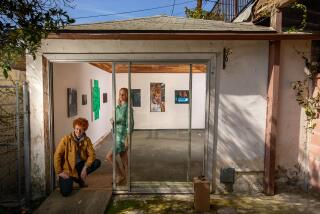Paul Kantor, 83; L.A. Dealer Showed Many Emerging Artists
- Share via
Paul Kantor, a pioneering Los Angeles art dealer whose galleries provided a sophisticated showcase for leading modern and contemporary artists in the 1950s and ‘60s, died Dec. 23 at Cedars-Sinai Medical Center. He was 83 and died of complications from Parkinson’s disease.
The son of a shoe salesman, Kantor was born in Brooklyn, N.Y., in 1919, but spent his adult life in Southern California, where he developed a sharp eye for artistic excellence. He presented the first Los Angeles exhibitions of works by many artists who would become internationally renowned, including California painter Richard Diebenkorn and Abstract Expressionists Robert Motherwell, Mark Rothko, Adolph Gottlieb and Willem de Kooning.
Kantor often complained about the difficulties of selling fine art in a town steeped in popular culture. “The whole art community here operates at such a low level, they deserve galleries where they can pay a dollar down and a dollar a month for art,” he told a Times interviewer in 1975. But he built a clientele of high-profile Hollywood figures who appreciated his taste, including producer William Goetz, director Billy Wilder, MCA chief Lew Wasserman and playwright Clifford Odets.
“Paul was a very important dealer for Los Angeles,” said Manny Silverman, whose West Hollywood gallery presents exhibitions by some of the artists Kantor represented. “He always had a fine eye for quality and a great acumen for business.”
Kantor studied philosophy, psychology and art at Brooklyn College, then served in the Navy during World War II. In 1946, while visiting relatives in San Francisco and looking for a place to settle, he took a fateful bus trip to Los Angeles. He soon married a fellow passenger, painter Josephine Morris, and made Southern California his home.
Kantor said that he got into the art business by accident in the late 1940s, when he loaned money to artists who ran the Fraymart Gallery on La Brea Avenue. He took over the gallery when he discovered that he was liable for their debts. To make ends meet, he turned part of the space into a frame shop and supplemented his income by writing a newsletter for the Seafarers Union.
But Kantor was onto something, and as his knowledge of art grew, he developed a business that commanded attention. He moved the Fraymart Gallery to a tonier neighborhood on Beverly Boulevard in 1950 -- the same year he discovered Diebenkorn’s work, at an annual juried exhibition at the Los Angeles County Museum of History, Science and Art in Exposition Park. Diebenkorn’s painting didn’t win the big prize, as Kantor thought it should, but he tracked down the artist, who was teaching at the University of New Mexico at Albuquerque, and bought three paintings for $300.
“It was all the money I had,” Kantor said.
He changed the gallery’s name to Kantor Gallery in 1952. Five years later, he relocated his business to Camden Drive in Beverly Hills, near the gallery run by his friend Frank Perls.
In 1959, after Kantor’s first marriage had ended in divorce, a young German woman, Ulrike Wegener, came into his gallery to see whether he would buy a Joan Miro watercolor she was trying to sell. They didn’t agree on a price, but met by chance at a restaurant a year later and married soon thereafter.
Kantor closed his gallery in 1966 and began doing business from his house. “I didn’t want to be a shopkeeper in Beverly Hills anymore, but I’ve never wanted to stop dealing,” he told The Times in 1995. “I love the subject, and I love having the work around. I just don’t like having to deal with people.”
In his later years, he cultivated a gruff manner and recounted frustrations with Los Angeles collectors. One favorite story featured Marcia Simon Weisman, who asked Kantor when he was going to take down an exhibition of Georges Rouault’s prints and graphics and put up something new.
“I’ll change the show when someone buys one,” he responded.
Kantor also criticized Weisman’s brother, industrialist Norton Simon, who became notorious for grilling experts about potential art purchases and then making his own decisions while building the collection housed at his museum in Pasadena. Simon could have had an even better collection if he had listened to the experts, Kantor said. But almost in the next breath, he dismissed Simon as a collector who “bought by consensus.”
Despite such laments, Kantor built a lucrative business, mainly by buying multimillion-dollar artworks by Pablo Picasso and other major artists in partnership with other dealers and selling them privately in Los Angeles. He also inspired his wife and a son to become art dealers.
Paul and Ulrike Kantor were divorced in 1973 and remarried in 1996. She ran her own galleries during the late 1970s and ‘80s, while she was single. Their son Niels Kantor opened the newest Kantor Gallery in 1994 on Melrose Avenue, where he shows contemporary art.
Kantor is survived by his wife; four sons, Anatole, James, Niels and Philip; a daughter, Siulan; a brother, Robert; and two grandsons.
More to Read
The biggest entertainment stories
Get our big stories about Hollywood, film, television, music, arts, culture and more right in your inbox as soon as they publish.
You may occasionally receive promotional content from the Los Angeles Times.










